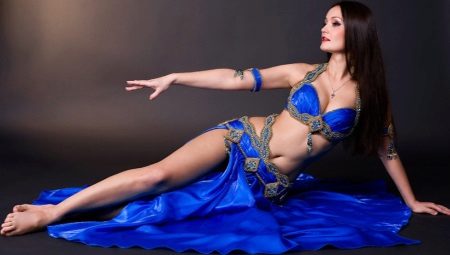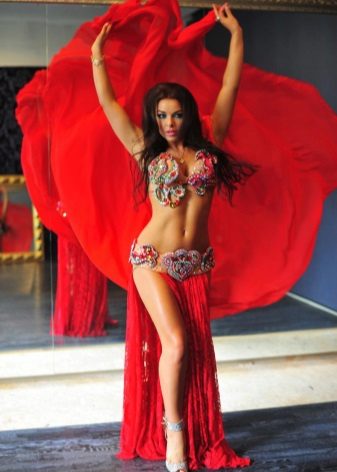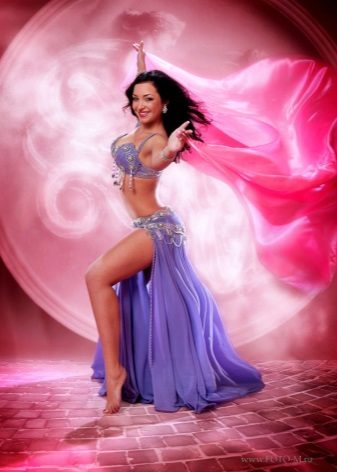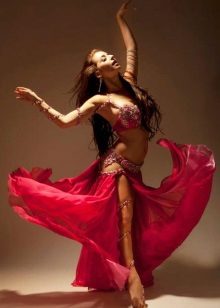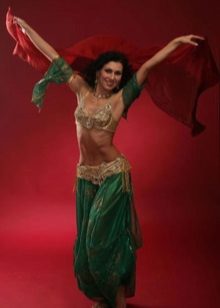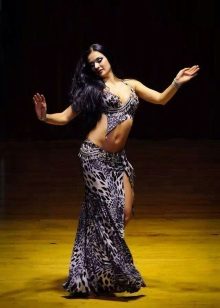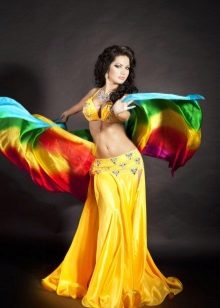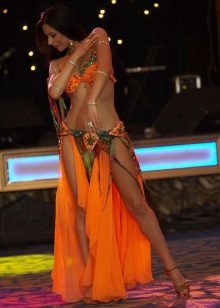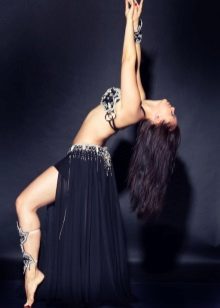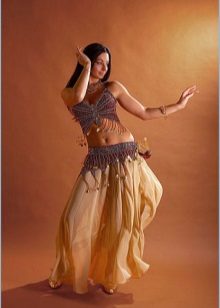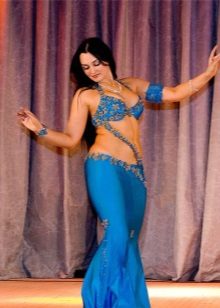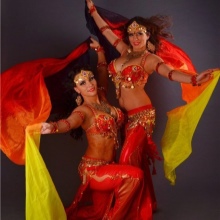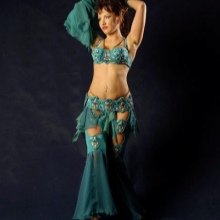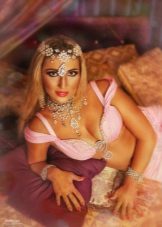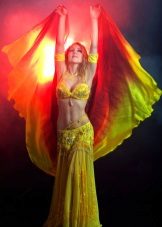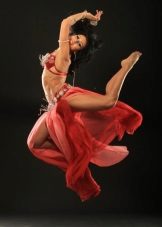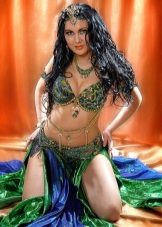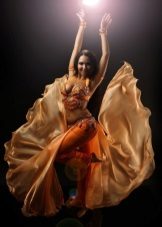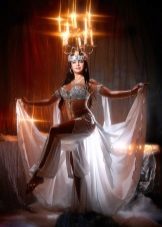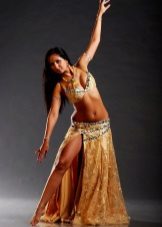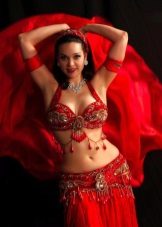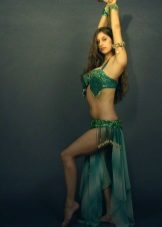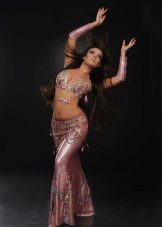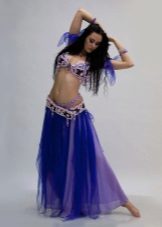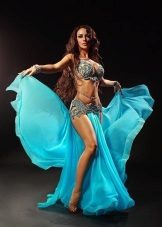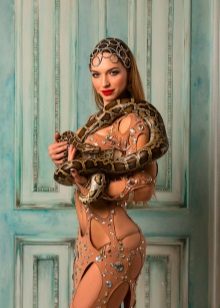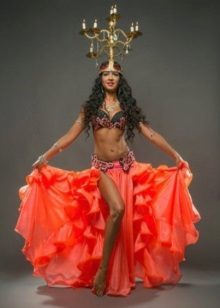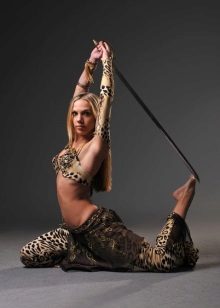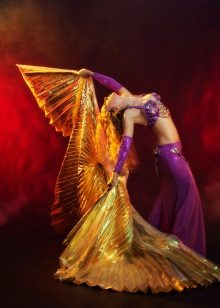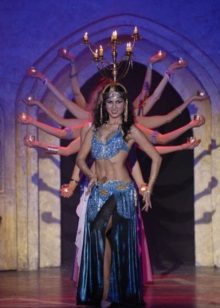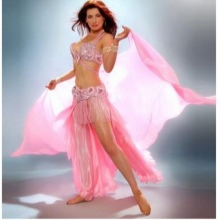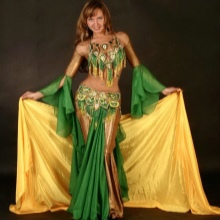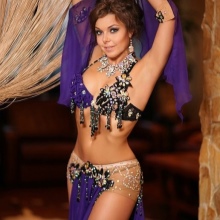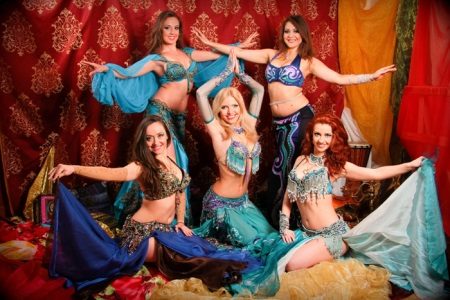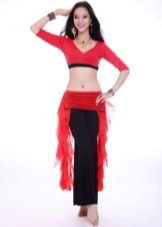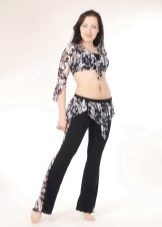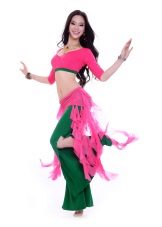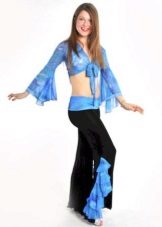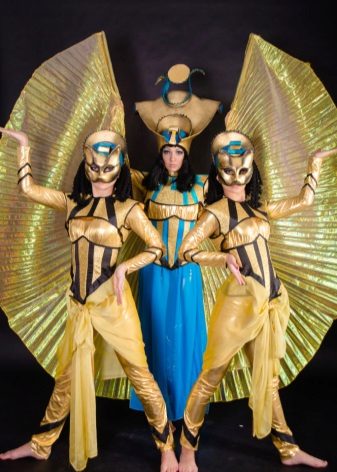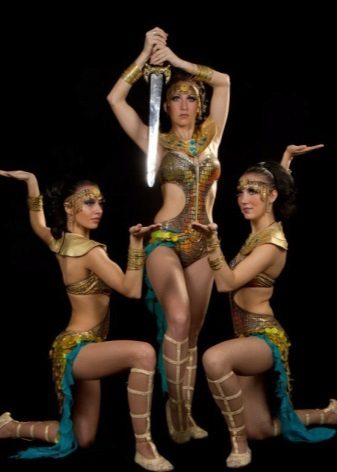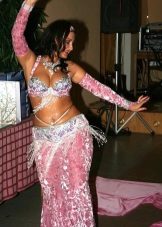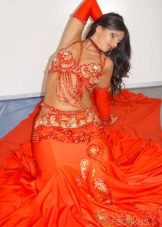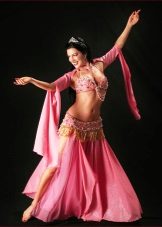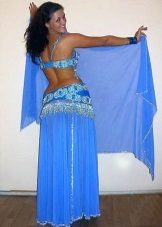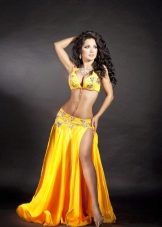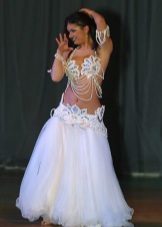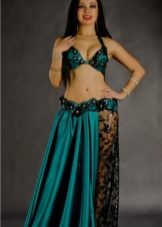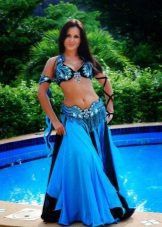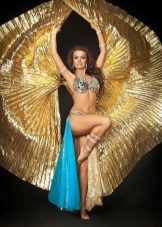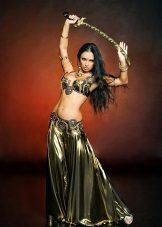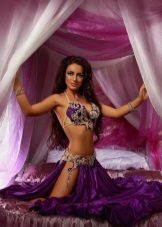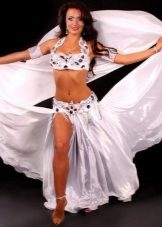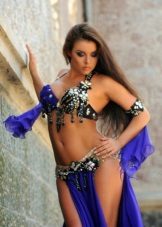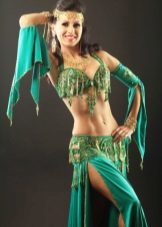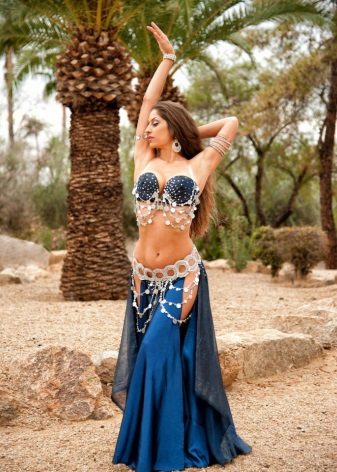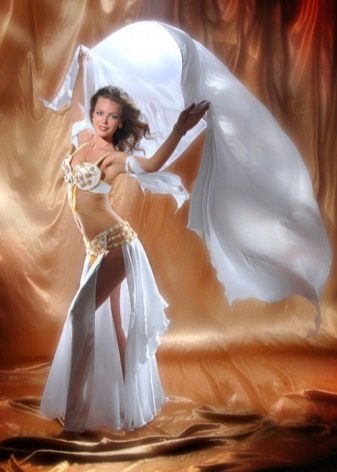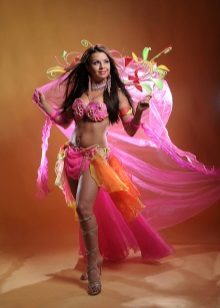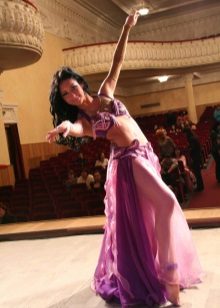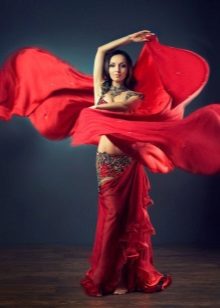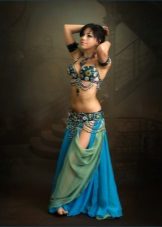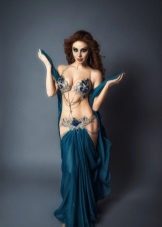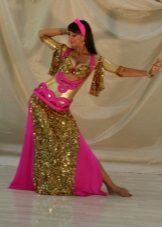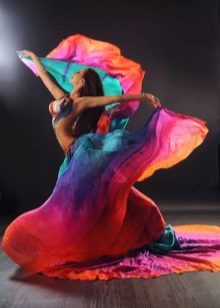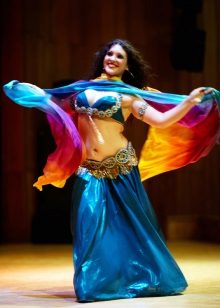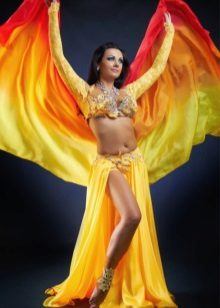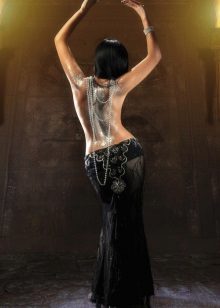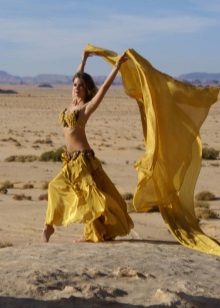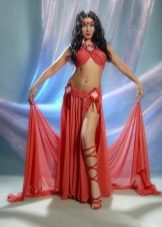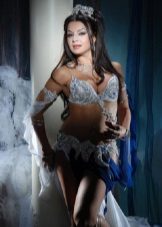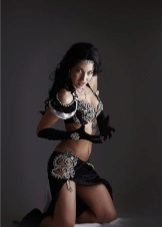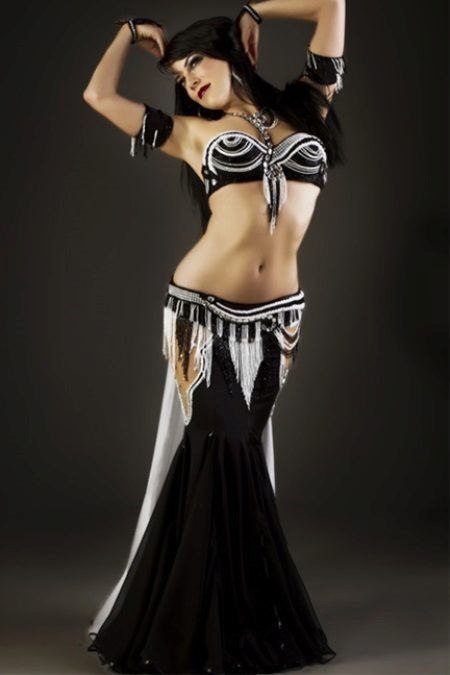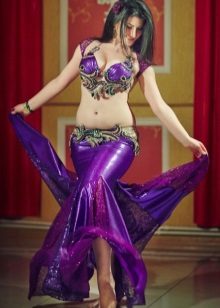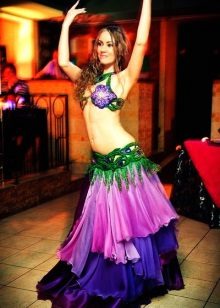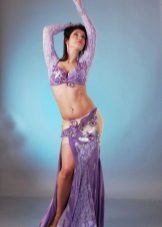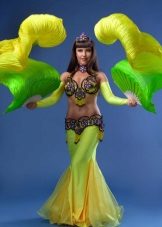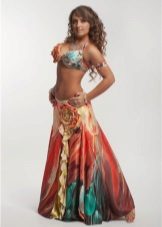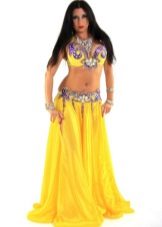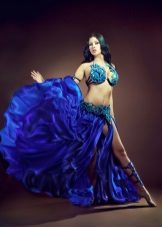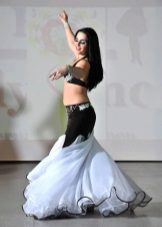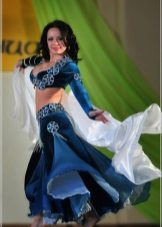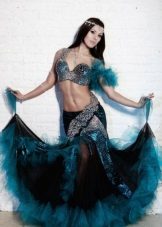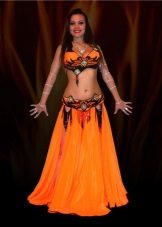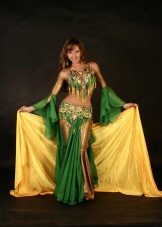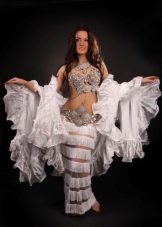Seductive swaying of the hips, undulating movements of the abdomen, mysterious look, grace and plasticity - all this is about belly dancing, which is popular all over the world. A special role in this emotional and bright spectacle is performed by the oriental costume of the dancer.
Features and elements
The spectacular dancer's outfit defines half the success of oriental dance. It favorably presents the dignity of the figure and masks the flaws, visually increases the amplitude of movements and accentuates all the bends of the body. Oriental costume always looks luxurious, bright, sparkles with a multitude of brilliant decoration.
The dress for traditional belly dance has the name Bedla. It consists of a bodice, a skirt (as an option - harem pants) and a belt.
Skirt style has different options: wide (cut “sun” or “half-sun”) or straight model (“fish” silhouette or with cuts), with low or high waist. This detail of the dress is sewn from light flowing material. During the dance, it creates a plume effect.
As the bottom of the suit, you can choose the harem pantswhich emphasize the roundness of the hips. Classic trousers for oriental dance are wide, have a fit on the hips, are fought on the ankle.
The top of the dancer's outfit is the bodiceusually quite open, often with a push-up effect. It fits the female body, so that chest movements captured the audience’s attention during the dance. As a rule, the bodices are decorated with various decorations: rhinestones, sparkles, sequins, beads. An elegant fringe is often sewn to this part of the costume.
The belly in a classic Oriental costume remains open, because the dance shows it. But there are variations of dress with a veil covering this part of the body, especially designed for performances in front of a conservative public.
A necessary item of clothing of a dancer is a belt or shawl decorated with monists and other rich decor. During the movements of the oriental beauty, these details of clothing, tied at the hips, melodiously ring, increasing the rhythm of the dance. Dense belt is usually sewn to a wide elastic band to sit well on the hips and not move. The shawl has a rectangular or triangular forum, decorated with beautiful fringe.
As for shoes for stage costumes, most dances suggest their performance barefoot. Although today some modern eastern dances allow even high heels.
An integral part of belly dancing - its attributes, or accessories, which give it a special unique piquancy. These are fans, canes, feathers, candelabra, a cascade of bracelets and much more. All these things fascinate the viewer, convey the characteristic meditating oriental flavor and have their own symbolism. For example, such an attribute as a saber personifies the rebelliousness of a woman. An unforgettable sight is the dance with the snake.
Varieties
It should be noted that the elegant seductive costumes of oriental dancers, which we see on the stage, cannot be called traditional. They arose as a result of the popularity of belly dancing in European countries and the United States and created the image of a passionate seducer. For women of the East, such clothes are unacceptable, their ethnic costumes are much more modest. Performing a dance, they sometimes just tie a scarf on the hips, emphasizing body movements.
That is why costumes for a fascinating belly dance in our modern sense is only a stage image.
Often, the oriental choreographic number is performed collectively, in this case, the outfits of all the participants must be coordinated, performed in the same style.
A gorgeous performance is the result of the work of a professional dancer. But to master all the subtleties of belly dancing, of course, you need to train for a very long time. And here will help you a comfortable and functional training suit. This clothing is a simplified version of stage outfit, but not of such a presentable look. In the classroom, a handkerchief (belt) is especially necessary in order to work out the rhythm of movements. During rehearsals, the dancer can put on soft ballet flats or shoes on her feet, although their color is not always combined with clothes.
There are a large number of styles of oriental choreography, as well as the main directions.
The Egyptian school is characterized by a more chaste dance variant. Traditional dresses of dancers, as a rule, closed - a long dress with an accessory in the form of a shawl, tied at the hips. The modern version of the Egyptian dress is more extravagant, it emphasizes the curves of the figure, it has cuts and open neckline.
Turkish choreography is much more sensual, dances on the tables and contact with the audience during the performance are common. Today, the typical Turkish Oriental dance for us is a seductive composition with a pole. Dresses of dancers in the Turkish style, of course, very frank.
A feature of the Arab school - it is called Haliji (this word translates as “Gulf”, meaning the countries of the Persian Gulf) are certain movements of flowing hair (rotations, sweeps of hair, their fascinating reversals), claps, shaking breasts, special steps. Initially, women performed such a dance for each other. And the traditional clothes for him are a rather loose dress, having traditionally wide sleeves and rich decor.
A separate choreographic trend today is art-east, in which oriental motifs are interwoven with the characteristic rhythms of other countries. (Latin America, Spain, Africa and many others). As for music, traditional oriental rhythms recede into the background, often eclipsed by club-style music electronic processing. The costumes for such dances are very bold, using a variety of traditional and unusual accessories. This modern European invention is created for its own viewer. But more recently, this boom has affected our country.
Fabrics
Consider briefly the popular fabrics that are used when sewing oriental costumes:
- Light transparent chiffon goes for tailoring of wide flying skirts (for example, double or triple or “sun” style), veils on the face. As an option - chiffon, having a sputtering of spangles (only one side glitters) or crepe-chiffon, more dense.
- Crepe satin is an opaque material that resembles satin. Suitable for the scene because of its brilliance in the light of bright spotlights. However, its disadvantage is a tendency to puffs.
- A striking sequin fabric, similar in appearance to scales, is used in the decoration of bodices and belts. A cheap option is hard and hot for the body, expensive - equipped with a knitted mesh.
- Velvet (the best option - also on a knitted or stretch fabric), which covers the bodices and belts. On a skirt from a soft velvet chiffon wedges effectively look.
- Biflex is a fairly dense knitwear material that stretches well in all directions. Designed for the same purposes as velvet.
- Light transparent organza, smooth or embossed, meets 3D effect. For a solid skirt, this material is not suitable because it does not have softness.
- Sparkling brocade (hard or soft), suitable mainly for dressing.
When choosing fabric for a stage costume, consider the fabric texture. Non-sweeping materials will be more practical: such a suit is convenient to fold into a bag.
If the performance is scheduled outside, do not wear synthetic materials - the skin will not breathe. Keep in mind that even small spots will be noticeable on bright clothes. Choose a material that can withstand hand washing.
Color solutions
The color scheme of Oriental costumes is rich and diverse. Always a win-win option - solid colors: especially if it is gorgeous gold, silver, emerald, pink, bright red. Black outfit with golden decor looks luxurious and fascinating. Various floral patterns look no less impressive.
In general, the color of the bodice, skirt and scarf, above all, should meet your sense of energy of the dance. For example, for a particularly passionate image, choose a red or black base color. For the more chaste, white or silver.
Manufacturers
A large assortment of ready-made oriental costumes are offered by Chinese manufacturers.
In online stores you can also purchase handmade outfits sewn in the best studios of the East - these are Yasser, Ahmed Omar, Mahmoud Abd el Ghaffar.
Noteworthy are models made in the USA and the UK (for example, the British firm Bristol Novelty Ltd.
Charming costumes for oriental dances are also offered by Russian producers: Balagan, Vestifika, Karnavalof. Stage clothes from the designer Polina Polinadcd are noteworthy.
Not to mention the only in our country, the male designer of oriental costumes. This is Anrey BuryninWith a stage name Khalif, he is the head of Amrita, a famous oriental dance school, teacher and choreographer. In just three years of work, he created about 40 exclusive models of different styles. His outfits are notable for complex embroidery techniques, often decorated with semi-precious stones (for example, turquoise, coral) and rhinestones (Swarovski crystals). In general, designer clothes are made in a classic style.
Rental
Note that the outfit for oriental dance is most convenient not to buy, but to rent. It diversifies the performances, you can choose a costume for each specific image (the femme fatale or the mysterious stranger), while saving money. In addition, if your skin color changes as a result of tanning, then here you will be helped by a suit rental, because the pale and tanned young ladies are different shades.
Provide such a service in special stores, and at a affordable price. (about 1000 rubles for several days). Besides, a huge plus is that you don’t have to take care of your stage costume, and in view of its specifics, this is a very hard work.
